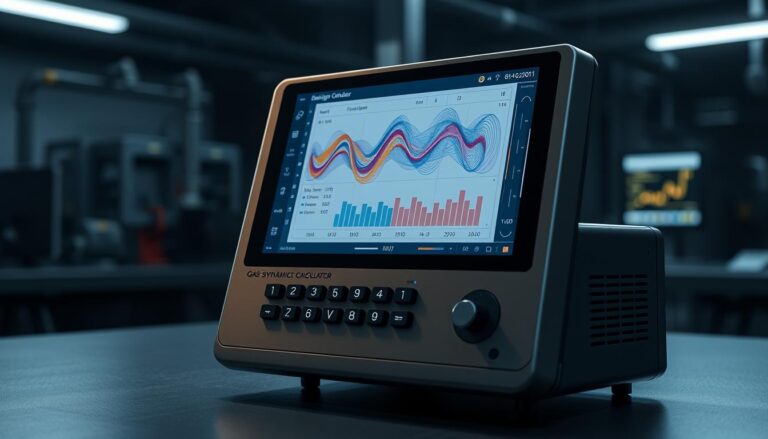The gas dynamics calculator is a powerful tool for analyzing fluid flow in engineering. It helps optimize fluid flow, cut costs, and boost system efficiency. With it, users can quickly find important values like pressure, temperature, and velocity. By using a gas dynamics calculator, engineers get precise results. This is key for any engineering project. The calculator offers a detailed fluid flow analysis, making it essential for engineers.
Understanding Gas Dynamics Fundamentals
Gas dynamics is key in fluid flow systems, and understanding gas dynamics is vital for engineers. It helps them make precise gas flow calculations. Gases behave differently based on pressure, temperature, and speed. Knowing the basics of gas flow and its properties is crucial.
Engineers need to understand gas dynamics to design better systems. This includes pipelines, turbines, and compressors. Gas flow calculations are important here. They help predict how gases act under various conditions. This knowledge ensures these systems work safely and efficiently.

- Conservation of mass, momentum, and energy
- Viscosity, thermal conductivity, and specific heat capacity
- Pressure, temperature, and velocity relationships
Mastering these concepts helps engineers use gas dynamics to its fullest. They can improve pipeline flow and design more efficient turbines. A strong understanding of gas dynamics is key to success in this field.
Features of Our Gas Dynamics Calculator
Our gas dynamics calculator is made for quick and precise calculations in engineering. It handles pressure, temperature, velocity, flow rate, density, and viscosity. It’s a must-have for aerospace, industrial processing, and power generation engineers.
The key features of our gas dynamics calculator include:
- Pressure and temperature calculations
- Velocity and flow rate calculations
- Density and viscosity calculations
With our calculator, users can quickly get accurate results. This saves time and cuts down on mistakes. It’s also great for HVAC systems, where precise calculations are key for efficient design and operation.
Our calculator is designed for engineers in aerospace, industrial processing, and power generation. It offers accurate and efficient calculations. This helps engineers design and optimize systems better, reducing errors and boosting performance.
Essential Parameters in Gas Flow Analysis
In gas flow analysis, several key factors are important for accurate results. In aerospace engineering, knowing these factors is crucial. It helps in designing and optimizing systems. The goal is to analyze fluid flow well, considering various properties and relationships.
Essential parameters like Mach number, pressure, temperature, density, and velocity are critical. These factors are connected and affect each other. It’s important to look at them together. By analyzing these, engineers can understand the flow’s nature and make better decisions.
- Mach number calculations to determine the nature of the flow
- Pressure and temperature relations to understand the behavior of gases
- Density and velocity considerations to calculate key parameters such as flow rate and pressure drop
By studying theseessential parameters in gas flow analysis, engineers inaerospace engineeringand other fields can improve their systems. They can achieve more efficient and effective results.
How to Use the Gas Dynamics Calculator
To start with the gas dynamics calculator, you need to know the basics of gas flow. It’s designed to be simple, so you can easily put in the needed info and get precise results. It’s great for industrial processing to make fluid flow better, cut down energy use, and boost system efficiency.
Here’s how to use the gas dynamics calculator:
- Enter the needed details like pressure, temperature, and speed.
- Pick the right units for your input values.
- Choose what you want to calculate, like Mach number or pressure ratio.
- Hit the calculate button to see your results.
The gas dynamics calculator is a key tool for engineers and researchers in industrial processing and more. By following these steps, you can learn how to use gas dynamics calculator and get precise results. Its easy-to-use design and strong calculation features make it a must-have for gas flow and fluid dynamics work.
Applications in Various Engineering Fields
The gas dynamics calculator is used in many engineering fields. It helps in fluid flow analysis to improve system design and efficiency. Engineers rely on it to get precise results, cut costs, and boost system performance. It’s crucial for analyzing fluid flow in these fields.
Here are some key areas where the gas dynamics calculator is used:
- Aerospace engineering, for designing fluid flow systems in aircraft and spacecraft
- Industrial processing, to optimize fluid flow, lower energy use, and enhance system efficiency
- Power generation systems, for designing fluid flow systems in power plants
- Heating, ventilation, and air conditioning (HVAC) applications, for fluid flow system design and optimization
Using the gas dynamics calculator helps engineers create efficient systems. This leads to cost savings and better performance. Its role in fluid flow analysis is vital for engineers in these fields.
Common Challenges and Solutions in Gas Dynamics Calculations
Engineers often face challenges when doing gas flow calculations. These include wrong input values, the wrong methods, and not enough data. A good gas dynamics calculator can help by checking input values and giving precise results.
Some common problems in gas dynamics calculations are:
- Wrong input values, like incorrect pressure, temperature, or velocity
- Using the wrong formula or ignoring important details like friction or heat
- Not having enough data about the gas or the system’s shape
Using a gas dynamics calculator helps engineers solve these issues. It checks input values, picks the right method, and gives accurate results. Engineers also use sensitivity analysis and uncertainty quantification to find and fix errors.
By tackling these common problems, engineers can make sure their results are trustworthy. This is key in fields like aerospace, industrial processing, and power systems. With the right tools and practices, engineers can get accurate results in gas flow calculations.
Best Practices for Accurate Results: gas dynamics calculator
To get accurate results in gas dynamics, it’s key to follow best practices. These ensure the input parameters and results are reliable and valid. In engineering, precise calculations are vital for designing and improving systems.
Following these practices helps engineers avoid mistakes and boost system efficiency. This leads to better performance overall.
Important steps include checking input parameters, understanding results, and solving problems. These steps are crucial for reliable gas dynamics calculations in engineering.
By sticking to these guidelines, engineers can make sure their work is based on solid assumptions and accurate data. This knowledge helps them make better decisions and optimize system performance. It’s especially useful in fields like aerospace, industrial processing, and power generation.
Adopting these best practices brings many benefits:
- More accurate and reliable calculations
- Less chance of errors
- Systems work better and more efficiently
- Better decision-making and optimization
By using these practices, engineers can ensure their gas dynamics work is precise and relevant. This leads to better system performance, efficiency, and success.
Conclusion
The gas dynamics calculator is a key tool for engineers in many fields, like aerospace and industrial processing. It helps them understand fluid flow better. This leads to saving energy and making systems more efficient.
It’s useful for designing turbines, improving HVAC systems, or optimizing chemical plants. The calculator helps in managing fluid flow and reducing pressure losses. By following the tips in this article, you can rely on your calculations. This leads to better decisions and cost savings.
As we look for ways to save energy and protect the environment, this calculator is crucial. It helps engineers improve fluid dynamics and stay at the forefront of technology. Using this tool can open up new opportunities and help us move towards a greener future.
FAQ’s About gas dynamics calculator
What is a gas dynamics calculator?
A gas dynamics calculator is a tool for engineers. It helps them improve fluid flow in many areas. It calculates important things like pressure, temperature, and velocity.
What are the basic principles of gas flow?
Gas flow basics include mass, momentum, and energy conservation. These are key for figuring out pressure, temperature, and velocity.
What are the key gas dynamic properties?
Important gas properties are viscosity, thermal conductivity, and specific heat. These affect how gases behave in different situations.
What features does the gas dynamics calculator include?
It can calculate pressure, temperature, velocity, and flow rate. It also figures out density and viscosity. It’s vital for aerospace, industrial processing, and power systems.
What are the essential parameters in gas flow analysis?
Key parameters include the Mach number, pressure and temperature, and density and velocity. These are crucial for precise results.
How do I use the gas dynamics calculator?
It’s easy to use. Just enter the needed values like pressure and temperature. The calculator then gives you accurate results. It’s designed to be simple and quick.
What are the common applications of the gas dynamics calculator?
It’s used in aerospace, industrial processing, power systems, and HVAC. It’s very versatile.
What are the common challenges in gas dynamics calculations?
Challenges include wrong input values, bad calculation methods, and missing data. The calculator helps by checking inputs, choosing the right method, and giving correct results.
What are the best practices for achieving accurate results with the gas dynamics calculator?
For accurate results, verify inputs, follow result guidelines, and use troubleshooting tips. The calculator supports these practices, helping engineers in many fields.


